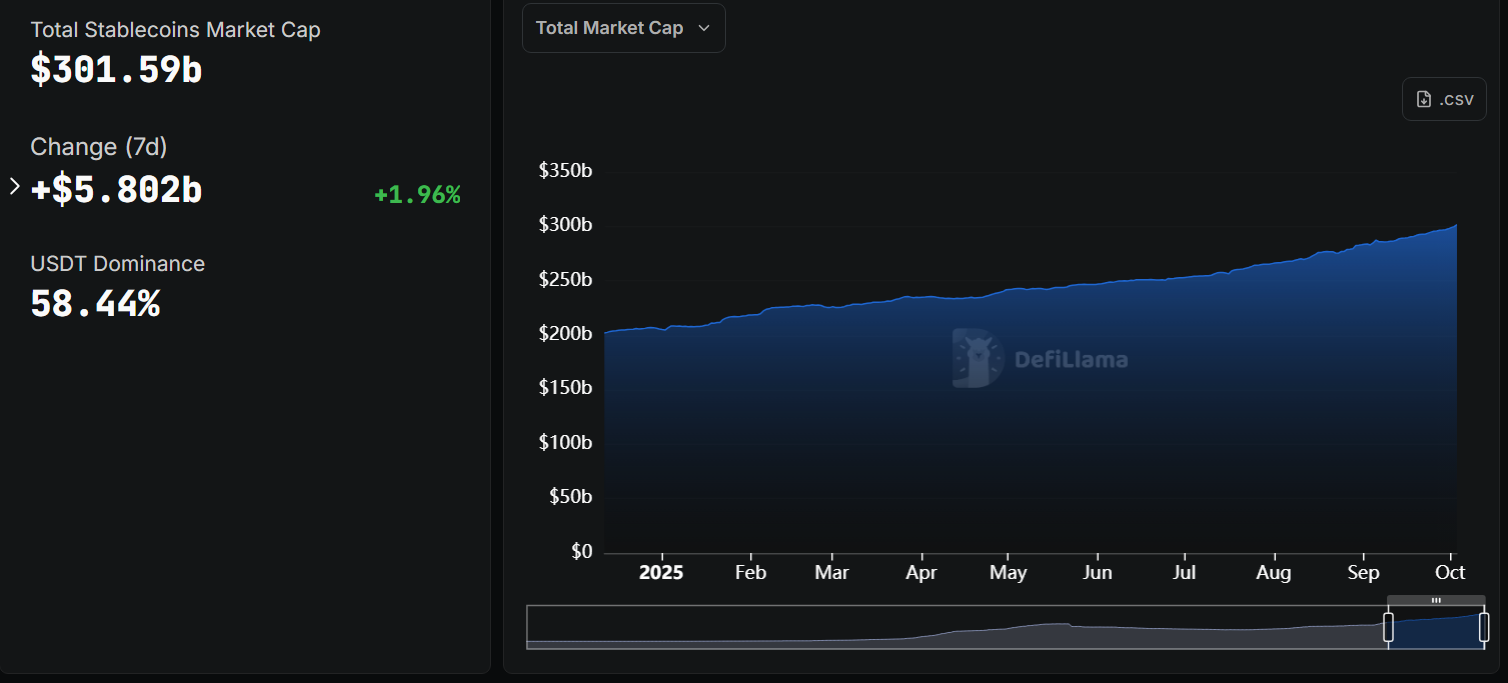Stablecoin market breaks past $300b for the first time
The stablecoin market cap surpassed the $300 billion threshold for the first time in history, marking a significant milestone in the rapid boom of widespread financial adoption.
- The global stablecoin market cap has crossed over the $300 billion mark for the first time in history, led by Tether’s USDT dominance.
- While USD-backed tokens remain the largest share, new euro- and local currency-pegged tokens are emerging in Europe and Asia under evolving regulatory frameworks.
According to data from DeFi Llama, for the first time in history, the global stablecoin market cap has surpassed $300 billion in just the span of one day. On Oct. 3, the market is valued at approximately $301.59 billion.
The surge is fueled by the rapid rise of USD-pegged tokens and widespread global adoption, specifically among traditional banks and with emergence of government regulations.
Tether’s USDT (USDT) continues to be the largest contributor to the boom; dominating the market by around 58.44%. According to the on-chain data site, Tether holds a market cap valued at $176.24 billion with a slight increase of 0.39% in the past 24 hours and 1.54% in the past week.

Tether’s dominance is followed by the second largest issuer, Circle. Circle’s USD Coin (USDC) has a market cap of $74 billion. In third place is Ethena’s USDe (USDE), with a market cap of $14.81 billion.
In terms of network, Ethereum (ETH) hosts the largest portion on-chain with around $171.2 billion in circulation. This is followed by Tron (TRX), which hosts around $76.7 billion of stablecoins on the market. Other chains hold less than $13 billion of the fiat-pegged tokens in circulation.
Stablecoin domination hits new global peak
According to data from RWA.xyz, the monthly transfer volume for stablecoins has reached $3.27 trillion. The number dipped slightly by 7.59% compared to last month, but it was apparently enough to boost the market value past $300 billion. At the moment there are 27 million active addresses transacting stablecoins.
Although most of the tokens in the market are pegged to the U.S. dollar, there have been a number of firms vying for issuer licenses so they may start launching their own tokens pegged to other currencies. These firms hope to create tokens that will challenge the domination of USD in the market.
Another emerging class of fiat-pegged tokens is the euro-backed stablecoin, which saw nine European banks banding together to create their own venture that would provide euro-pegged tokens compliant to the EU’s Markets in Crypto-Asset regulation or MiCA.
However, euro stablecoins would need to pick up the pace if they want to compete with the USD-pegged tokens. Data from CoinMarketCap shows that EUR tokens only make up about $644 million of the total global market cap of more than $300 billion, still a relatively small portion compared to the USD token’s $306 billion market cap domination.
Most recently, Singapore was able to beat Hong Kong in launching its own local currency-pegged stablecoin, the XSGD. The token was launched on Coinbase in September 2025, having received the green light from the Monetary Authority of Singapore, indicating that it was compliant with the country’s upcoming stablecoin framework.
Despite already having a working regulatory framework, Hong Kong authorities have yet to grant any issuer licenses and claim that no licenses will be granted within this year. The queue of firms interested in issuing their own fiat-backed digital asset has expanded to include many players from China who are interested in launching their own yuan-backed tokens.
Disclaimer: The content of this article solely reflects the author's opinion and does not represent the platform in any capacity. This article is not intended to serve as a reference for making investment decisions.
You may also like
Avail's Intent-Driven Nexus Addresses the Issue of Fragmented Liquidity Across Chains
- Avail launches Nexus Mainnet, a cross-chain solution unifying liquidity across Ethereum , Solana , and EVM networks. - The intent-solver model enables seamless asset transfers without technical complexities, streamlining user experiences. - Developers gain modular tools for multichain integration, reducing costs as cross-chain liquidity demand grows. - Nexus abstracts execution layers, offering unified balances and execution while addressing fragmentation challenges. - With $50B+ in cross-chain activity

From Guesswork to Practical Answers: Remittix's Wallet Highlights Crypto's Move Toward Real-World Use
- Remittix launched an App Store wallet, enhancing crypto accessibility with a user-friendly interface and cross-platform development plans. - The wallet's crypto-to-fiat module and CertiK/KYC verification aim to bridge digital assets with traditional finance, boosting investor confidence. - A $250,000 giveaway and 15% referral rewards drive community engagement, positioning Remittix as a utility-focused competitor in a consolidating market. - Analysts highlight its alignment with crypto's shift toward rea

Blockchain Faces a Quantum Countdown: Will Networks Adapt in Time?
- Major layer-1 blockchains prioritize quantum-resistant upgrades as NIST finalizes post-quantum (PQ) standards, addressing long-term risks from quantum computing advancements. - Networks like Algorand deploy lattice-based signatures (e.g., FALCON), while Cardano and Ethereum test hybrid solutions to protect ECDSA-based infrastructure from future quantum decryption threats. - Migration challenges include larger key sizes, complex key management, and incentivizing users to rekey dormant accounts, complicati
XRP News Today: XRP ETFs Attract Unprecedented Investments, But Price Remains Stuck Under Key Resistance
- XRP ETFs attracted $628M in inflows but token price remains below $2.22 resistance despite regulatory progress. - Solana ETFs saw $156M outflows vs XRP's $89M inflows due to technical issues and higher perceived risk. - Analysts highlight ETFs' role in liquidity but stress macroeconomic factors and technical barriers limit price breakthroughs. - XRP's 60-day range ($1.85-$2.15) contrasts with $3 price targets requiring sustained ETF demand and rate cut optimism.

